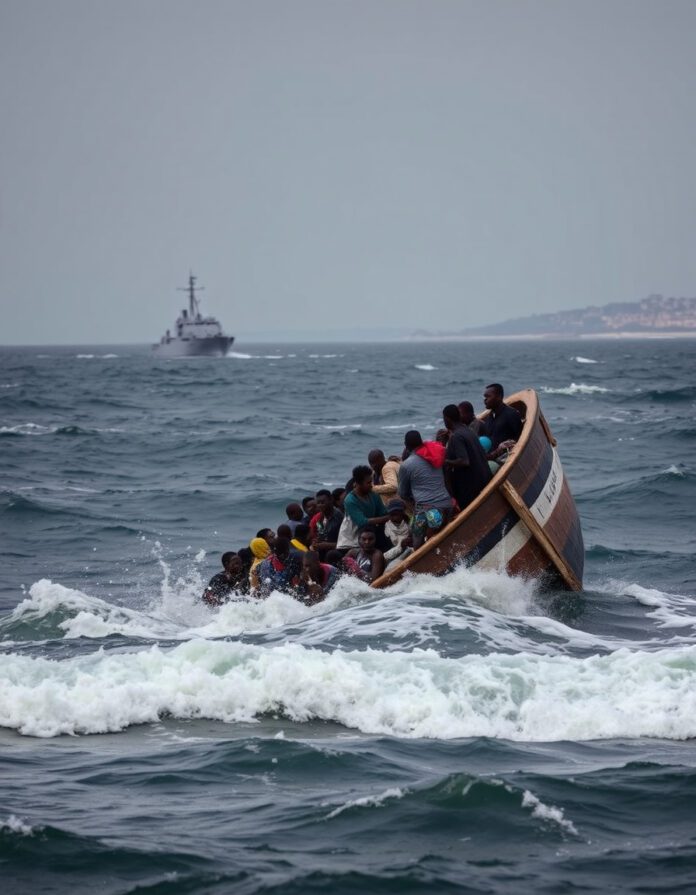A catastrophic disaster unfolded off Senegal’s coast when a migrant boat, carrying over a hundred individuals, capsized just miles from shore. This event, which occurred on Sunday, has led to the tragic loss of 26 lives. The Senegalese navy, engaged in ongoing rescue operations, has so far recovered the bodies of 26 victims, with many more still missing. The boat, part of a growing wave of migrant vessels attempting to reach Europe, succumbed to the dangerous waters of the Atlantic, underscoring the peril faced by migrants who take this treacherous journey. The migrant boat capsizes off Senegal with rising death toll incident occurred near the coastal town of Mbour, about 80 kilometers from Dakar
According to witnesses, the wooden fishing boat, or pirogue, was overloaded and unfit for the voyage. The vessel capsized just a few miles offshore, sending dozens of desperate passengers into the unforgiving Atlantic waters. Authorities quickly initiated search and rescue operations, recovering nine bodies initially. However, as search efforts progressed, an additional 17 bodies were recovered on Tuesday, raising the death toll to 26.
Despite the relentless efforts of the Senegalese navy, many individuals remain unaccounted for. Family members, loved ones, and local communities anxiously await news as the search for survivors and bodies continues. Authorities have also reported that the captain of the ill-fated boat, Cheikh Sall, has turned himself in to the police, where he is currently under investigation for his role in the tragedy.
Surge in Migrant Crossings to Europe
Senegal’s coastal towns have become key departure points for thousands of West African migrants seeking a better life in Europe. The migrant boat capsizes off Senegal with rising death toll tragedy is just one of many such incidents that occur along the perilous Atlantic route, which connects West Africa to Spain’s Canary Islands. This route is notorious for its deadly conditions, with strong currents and overcrowded, unseaworthy vessels leading to frequent shipwrecks.
According to data from Spain’s Interior Ministry, more than 22,300 migrants have reached the Canary Islands in 2024, marking a 126% increase from the previous year. Migrants fleeing poverty, conflict, and lack of opportunities in West African nations risk their lives on these dangerous voyages. The Atlantic route, one of the deadliest migrant routes globally, has claimed thousands of lives over the past few years. Many boats vanish without a trace, with human remains sometimes found months later, washed ashore in distant locations as far as the Caribbean.
Senegal’s government has ramped up efforts to curb illegal migration, launching patrol operations along the coast. In a recent operation in July, Senegalese authorities arrested 453 migrants and members of smuggling networks, half of whom were Senegalese nationals. However, despite these interventions, the lure of potential prosperity in Europe continues to draw migrants to embark on these perilous journeys.
The Human Cost of Migration
The tragedy of the migrant boat capsizes off Senegal with rising death toll brings into focus the human cost of the ongoing migration crisis. Migrants aboard these boats often come from impoverished backgrounds, with limited access to education, healthcare, or employment opportunities in their home countries. Driven by desperation, they seek a better life abroad, but the journey is fraught with danger. The risks include drowning, starvation, and exposure to the elements on the open sea. Many migrants also fall prey to unscrupulous smugglers, who profit from organizing these deadly crossings, with little regard for safety or human life.
In addition to the risks faced during the journey, those who reach Europe often face significant challenges, including harsh immigration policies, detainment, and deportation. For many, the promise of a better life remains elusive, as they navigate an uncertain future far from home.
As international organizations call for more robust action to address the root causes of migration, the people of Mbour and surrounding communities mourn the lives lost in this latest tragedy. The death toll may continue to rise as more bodies are recovered from the sea, a somber reminder of the dangers faced by those seeking to escape hardship in West Africa.
In conclusion, the migrant boat capsizes off Senegal with rising death toll incident has once again highlighted the perilous nature of the migration route from West Africa to Europe. As rescue efforts continue, the tragedy serves as a stark reminder of the human cost of migration and the urgent need for international cooperation to create safer, legal pathways for migrants seeking better lives abroad.
FAQs
What caused the migrant boat to capsize off Senegal?
The boat, overloaded with over 100 passengers, capsized due to strong Atlantic currents and poor seaworthiness, leading to a tragedy that claimed 26 lives.
2. Why are so many migrants leaving from Senegal?
Migrants from West Africa, including Senegal, are fleeing poverty, conflict, and a lack of job opportunities, seeking better prospects in Europe despite the dangers.
3. How many migrants have reached Europe through this route in 2024?
As of 2024, over 22,300 migrants have arrived in Spain’s Canary Islands, marking a 126% increase compared to the same period in 2023.
4. What actions are Senegalese authorities taking to prevent illegal migration?
The Senegalese government has intensified coastal patrols, arresting hundreds of migrants and smugglers to deter dangerous crossings, though many still attempt the journey.


